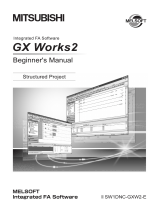
1-6 1.3 Terms
1.3 Terms
This manual uses the generic terms and abbreviations listed in the following table to discuss the
software packages and programmable controller CPUs. Corresponding module models are also
listed if needed.
Term Description
GX Works2
The product name of the software package for the MELSEC programmable controllersGX Developer
GX IEC Developer
Basic model QCPU A generic term for the Q00JCPU, Q00CPU, and Q01CPU
High Performance model
QCPU A generic term for the Q02CPU, Q02HCPU, Q06HCPU, Q12HCPU, and Q25HCPU
Process CPU A generic term for the Q02PHCPU, Q06PHCPU, Q12PHCPU, and Q25PHCPU
Redundant CPU A generic term for the Q12PRHCPU and Q25PRHCPU
Universal model
QCPU
A generic term for the Q00UJCPU, Q00UCPU, Q01UCPU, Q02UCPU, Q03UDCPU, Q03UDVCPU,
Q03UDECPU, Q04UDHCPU, Q04UDVCPU, Q04UDEHCPU, Q06UDHCPU, Q06UDVCPU,
Q06UDEHCPU, Q10UDHCPU, Q10UDEHCPU, Q13UDHCPU, Q13UDVCPU, Q13UDEHCPU,
Q20UDHCPU, Q20UDEHCPU, Q26UDHCPU, Q26UDVCPU, Q26UDEHCPU, Q50UDEHCPU, and
Q100UDEHCPU
High-speed Universal
model QCPU A generic term for the Q03UDVCPU, Q04UDVCPU, Q06UDVCPU, Q13UDVCPU, and Q26UDVCPU
QCPU (Q mode) A generic term for the Basic model QCPU, High Performance model QCPU, Process CPU, Redundant
CPU, and Universal model QCPU
LCPU A generic term for the L02SCPU, L02SCPU-P, L02CPU, L02CPU-P, L06CPU, L06CPU-P, L26CPU,
L26CPU-P, L26CPU-BT, and L26CPU-PBT
FXCPU A generic term for MELSEC-FX series programmable controllers
(FX0S, FX0, FX0N, FX1, FX1S, FX1N, FX1NC, FXU, FX2C, FX2N, FX2NC, FX3S, FX3G, FX3GC, FX3U, FX3UC)
CPU module A generic term for the QCPU (Q mode), LCPU, and FXCPU
QnU(D)(H)CPU A generic term for the Q02UCPU, Q03UDCPU, Q04UDHCPU, Q06UDHCPU, Q10UDHCPU,
Q13UDHCPU, Q20UDHCPU, and Q26UDHCPU
QnUDVCPU A generic term for the Q03UDVCPU, Q04UDVCPU, Q06UDVCPU, Q13UDVCPU, and Q26UDVCPU
QnUDE(H)CPU A generic term for the Q03UDECPU, Q04UDEHCPU, Q06UDEHCPU, Q10UDEHCPU,
Q13UDEHCPU, Q20UDEHCPU, Q26UDEHCPU, Q50UDEHCPU, and Q100UDEHCPU
Personal computer The generic term for personal computers where Windows® operates
IEC 61131-3 The abbreviation for the IEC 61131-3 international standard
Common instruction
A generic term for the sequence instructions, basic instructions, application instructions, data link
instructions, multiple CPU dedicated instructions, multiple CPU high-speed transmission dedicated
instructions, and redundant system instructions
Special instruction A generic term for the module dedicated instructions, PID control instructions, socket communication
function instructions, built-in I/O function instructions, and data logging function instructions
Application function A generic term for the functions, such as functions and function blocks, defined in IEC 61131-3.
(The functions are executed with a set of common instructions in a programmable controller.)





















